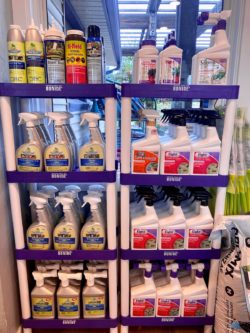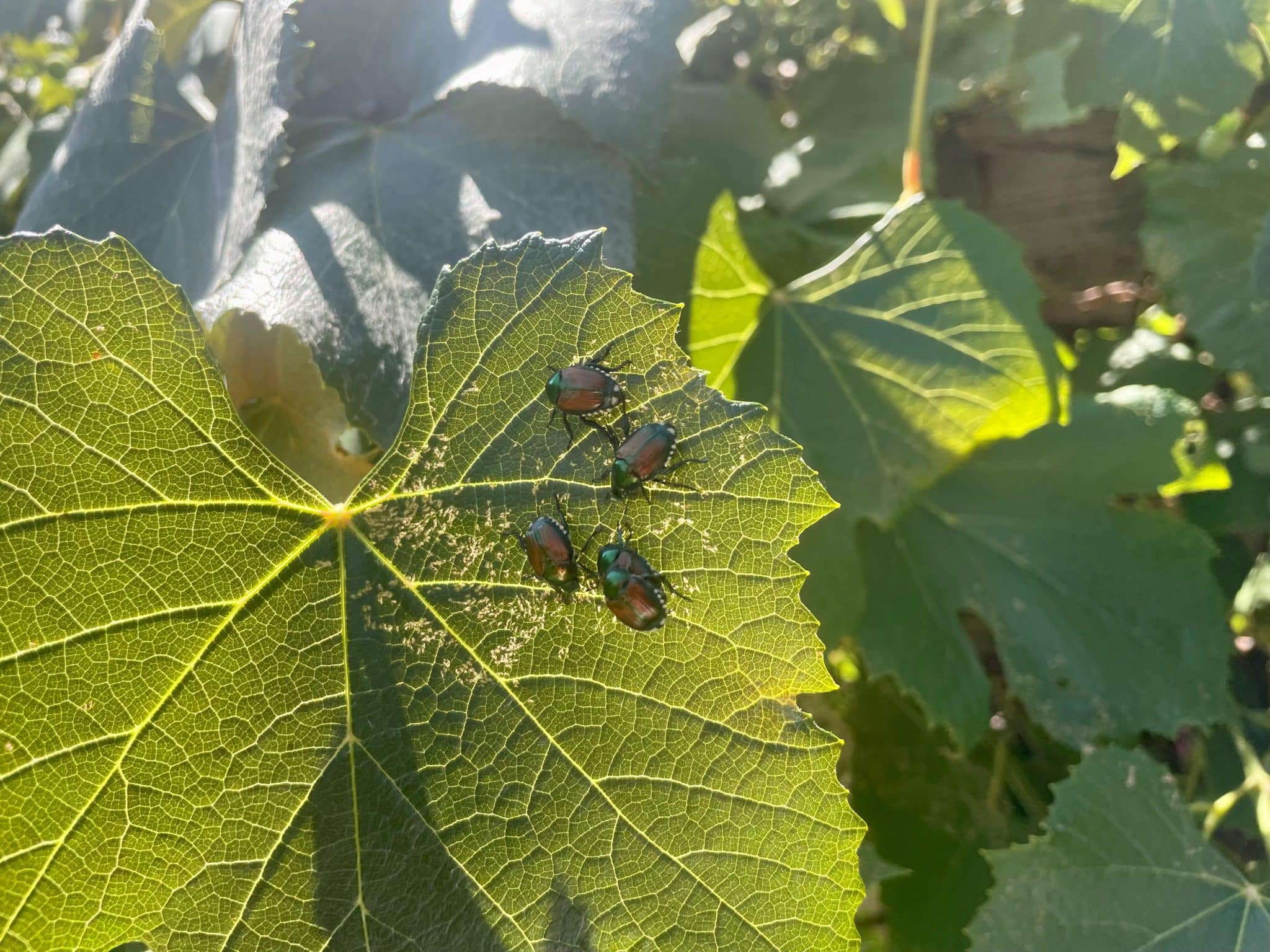Now is the time that pest and/ or disease problems are showing up. Keep an eye open for insects on the tips of branches or flower buds, or signs of chewing on the leaves or flowers. Put your thumb on the end of your hose and blast them off as an initial remedy. Consult you Green Team experts for treatment recommendations.
Japanese Beetles & Control
- Japanese beetles are here! They can be very damaging to plants, especially roses, grape vines, virginia creeper vines. Adults feed on leaves, buds and flowers of many common garden and landscape plants. Feeding on leaves is usually restricted to the softer tissues between the larger leaf veins, which results in a characteristic feeding pattern known and described as ‘skeletonizing’. More generalized ragged feeding occurs on softer tissues, notably flower petals; rose flowers are particularly susceptible to Japanese beetle injury. Damage on individual plants may be patchy, concentrated where aggregations of feeding beetles occur. Now is the time to put your control strategy together. More Japanese Beetle Info Here
Hand Picking Control
- Hand picking beetles is effective in small plantings. The beetles are easily picked or dislodged into a container of soapy water, especially in early morning and again in the evening. The regular removal of beetles prevents the feeding damage by those beetles and deters other beetles from aggregating on the plant. Beetle presence on plants and prior injury is attractive to other beetles.
Spray Control
 Adult Japanese beetles can be effectively controlled by use of sprayed insecticides which either kill and/or repel beetles and are particularly effective and may provide protection of plants for 2-3 weeks following a single application. As with all pesticide applications, read the label and follow the directions carefully. Make your application in the evening, after the sun has gone down so as not to disturb the honeybees. Best options below:
Adult Japanese beetles can be effectively controlled by use of sprayed insecticides which either kill and/or repel beetles and are particularly effective and may provide protection of plants for 2-3 weeks following a single application. As with all pesticide applications, read the label and follow the directions carefully. Make your application in the evening, after the sun has gone down so as not to disturb the honeybees. Best options below:- Bonide Eight Ready To Use trigger spray or Ready To Spray hose end application – synthetic pyrethrin – safer and softer in the environment than Sevin
- Natural Guard Spinosad Soap Ready To Use trigger spray or Ready To Spray hose end application – Spinosad with insecticidal soap – organic control
- Fertilome Indoor/Outdoor Multi-Purpose Aerosol Spray – synthetic pyrethrin – for convenient applications
- Fertilome Triple Action Ready To Use trigger spray or Ready To Spray hose end application – Neem oil, pyrethrins
- Fertilome Tree & Shrub Drench – mix with water in watering can, apply to soil – systemic action for roses
- Rescue Japanese Beetle Trap – very effective but best used away from your garden so as not to attract beetles to your plants
Budworms are showing up again!
 Now is the time to treat for Budworm again. These little light green worms have two cycles per summer – early July and early August. Budworms prefer to feed on petunia, geranium and verbena plants. They feed on the flower buds of these species. You might notice that there are less and less flowers, flowers that looked chewed upon, or little black worm droppings in the leaves.
Now is the time to treat for Budworm again. These little light green worms have two cycles per summer – early July and early August. Budworms prefer to feed on petunia, geranium and verbena plants. They feed on the flower buds of these species. You might notice that there are less and less flowers, flowers that looked chewed upon, or little black worm droppings in the leaves.- Treat with the biological Natural Guard Caterpillar Killer with BT, available in ready to use spray or dust. Or spray with Bonide Eight or Natural Guard Spinosad Soap. Treat now to help keep these flowers in full bloom all summer long.
Spots on Leaves
- Spots on the leaves could be the sign of a fungal disease, it could be incidental insects like thrips or leaf miners or it could be an environmental issue. It is important to match the correct pest control strategy with the pest problem. Water early in the day so that foliage is dry going into the night. Snap a photo or bring in a sample to the garden center to review with one of our Green Team experts. We offer a full range of solutions to help you solve your gardening problems and we are here to help!

